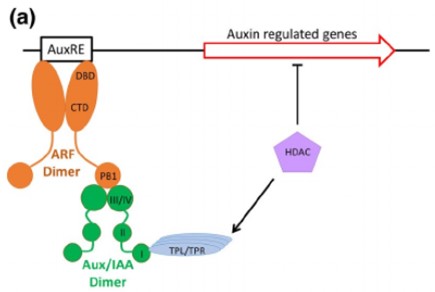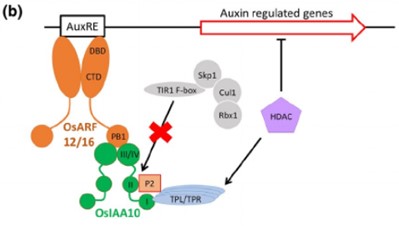Summary
Auxin hormone is one of the plant hormones, among other hormones, which include cytokinins, abscisic acid, salicylic acid, and ethylene. Unlike the other hormones, some of the roles of Auxin to plants include helping in the interlinkage of many behavior and processes of growth of the plants in their life cycle. This research paper has looked in-depth at areas such as Auxins inhibited signaling with an example Rice Dwarf Virus and the roles of auxins which include apical dominance maintenance and stimulation of stem extension.
Roles of Auxin in the growth and regulation of plants
Auxins stimulate stem extension while inhibiting the formation of lateral buds, allowing apical dominance to be maintained. The root tips, buds, and stems are responsible for their creation, whereas Indole Acetic Acid is a great example (IA) (Zhao, 2021). Auxin is a hormone that stimulates cell elongation and is produced by the stem tip. It goes to the plant’s darker side, enabling its cells to develop bigger than the lighter side. Phototropism is a plant movement in which the stem tip of the plant coils toward the light.
According to Ljung et al. (2005), Auxin is also required to maintain apical dominance. At the nodes where the leaves join to the stem, most plants generate lateral (or axillary) buds. Moreover, buds are latent meristems in the process of developing. The dormancy is maintained by Auxin as long as the apical meristem generates sufficient Auxin, and the lateral buds remain dormant (Ivanchenko et al., 2013). No auxin is produced if a scientist or a browsing animal removes the shoot apex. Consequently, the lateral buds will start to awaken and extend from their dormancy. The plant will get bushier as a consequence of this. Apical dominance may be seen when a gardener prunes a hedge.
Explain what auxins are
Auxin is a plant hormone made up of tryptophan, an amino acid. Auxins are a group of chemicals that all have a role in cellular regulation in some manner. According to Leyser (2018), plant hormones are available in five primary types: the auxin molecule. The most common Auxin is indole acetic acid or IAA. IAA is an auxin necessary for the development and growth of the plant cells and tissues.
How does the auxins mechanism work, and why is it a growth hormone
Auxin signaling is controlled by (ARFs) the auxin response factors and the indole acetic (Aux/IAA) proteins (Leyser, 2018). The ARF protein (TF) family has four domains that are highly conserved among plant species (Lavy & Estelle, 2016). Through an N-terminal B3-type DNA-binding domain, auxin-responsive elements (AuxREs) connect to ARFs as dimers to regulate auxin genes (Müllender, 2021). The flexible middle region of ARF proteins may activate or inhibit auxin-responsive genes. At low auxin concentrations, the Phox/Bem1p (PB1) domain of a C-terminal dimerization domain (CTD) enhances Aux/IAA protein homo and heterodimerization as depicted in the diagram below (Müllender, 2021). Because they respond to the cells’ auxin levels, aux/IAA proteins are essential regulators of auxin-mediated signaling. Auxin is a plant growth hormone that promotes cell proliferation and elongation (Shen, 1990). During the elongation phase, Auxin increases the plant wall flexibility allowing the plant to grow upward. Auxin affects root formation; when NAA or IBA is administered to a plant cutting from an original tree, rooting takes less time, significantly increasing the new plant’s chances of survival (Wang, 2017).

According to Chadwick and Burg (1970), Auxin is referred to as a growth hormone because it stimulates plant cell development and elongation and also influences the formation of roots. This is because some changes occur in the elongation phase, which includes the flexibility of the plant wall, making it simple for the plant to grow upwards. Wang et al. (2021) explain that when NAA or IBA is applied to a plant cutting from a parent plant, rooted takes less time for the young plant, boosting its chances of survival.
Auxin signaling inhibited by virus
According to Müllender et al. (2021), the Rice dwarf virus (RDV) has a well-studied technique in which the plant virus interferes with the auxin signaling, which results in rice dwarfism. Both early IAA-producing genes and auxin-responsive genes get down-regulated after RDV infection. The image below shows that the RDV P2 protein binds to OsIAA10’s domain II, blocking OsIAA10 from binding to OsTIR1. P2 also prevents OsIAA10 from becoming degraded either by SCFTIR1/AFBs complex via Auxin sensing in a dose-dependent manner (Zhang et al., 2020). Shorter crown roots, stunting, decreased seed output, and a higher number of tillers were seen in RDV-infected rice plants in transgenic rice plants overexpressing OsIAA10. Furthermore, following a natural RDV infection, these transgenic plants show more severe symptoms, despite OsIAA10 knockdown reducing viral proliferation and symptom severity.

How Auxins make Plants Grow More
Zhang et al. (2019) assert in their research that Auxin encourages shoot elongation, which aids plant development. Auxins promote cell elongation and plant length in tandem with gibberellins. Gibberellins, hence auxins, effectively lengthen the distance between nodes, spacing branch tips farther apart. Auxin causes cell elongation in shoots; therefore, high amounts of Auxin promote growth and larger cells. Auxin reduces cell elongation in the roots, restricting growth by shrinking cells (Xu et al., 2013).
According to Savina et al. (2020), Auxins promote root branching, which helps in plant development; it causes a cut stem to produce roots at the cut. Auxins go downwards and away from the light because of gravity (Zhang, 2019). Auxin-rich regions of the plant aid cell development, which influences main root extension and lateral root formation, hence regulating root system architecture (LR) (Li et al., 2018). Exogenous Auxin has been proven to reduce primary root elongation while increasing LR production.
In conclusion, the Auxins hormone has proven to be one of the critical hormones in the plant. They maintain apical dominance in the plant, help in embryonic development, development, and growth of a plant, help in differentiation and elongation, and transition to flowering. Moreover, auxin signaling is sometimes influenced by viruses, where excellent example of this is the Rice Dwarf Virus, Tobacco Mosaic Virus, and Beet Necrotic yellow vein virus.
References
Chadwick, A. V., & Burg, S. P. (1970). Regulation of root growth by auxin-ethylene interaction. Plant Physiology, 45(2), 192-200.
Ivanchenko, M. G., Den Os, D., Monshausen, G. B., Dubrovsky, J. G., Bednářová, A., & Krishnan, N. (2013). Auxin increases the hydrogen peroxide (H2O2) concentration in tomato (Solanum Lycopersicum) root tips while inhibiting root growth. Annals of Botany, 112(6), 1107-1116.
Lavy, M., & Estelle, M. (2016). Mechanisms of auxin signaling. Development, 143(18), 3226-3229.
Leyser, O. (2018). Auxin signaling. Plant Physiology, 176(1), 465-479.
Li, Z., Zhang, X., Zhao, Y., Li, Y., Zhang, G., Peng, Z., & Zhang, J. (2018). Enhancing auxin accumulation in maize root tips improves root growth and dwarfs plant height. Plant Biotechnology Journal, 16(1), 86-99.
Ljung, K., Hull, A. K., Celenza, J., Yamada, M., Estelle, M., Normanly, J., & Sandberg, G. (2005). Sites and regulation of auxin biosynthesis in Arabidopsis roots. The Plant Cell, 17(4), 1090-1104.
Müllender, M., Varrelmann, M., Savenkov, E. I., & Liebe, S. (2021). Manipulation of auxin signaling by plant viruses. Molecular Plant Pathology, 22(11), 1449-1458.
Savina, M. S., Pasternak, T., Omelyanchuk, N. A., Novikova, D. D., Palme, K., Mironova, V. V., & Lavrekha, V. V. (2020). Cell dynamics in WOX5-overexpressing root tips: the impact of local auxin biosynthesis. Frontiers in Plant Science, 11, 1529.
Shen, W. H., Davioud, E., David, C., Barbier-Brygoo, H., Tempe, J., & Guern, J. (1990). High sensitivity to auxin is a common feature of hairy root. Plant Physiology, 94(2), 554-560.
Wang, M., Li, P., Ma, Y., Nie, X., Grebe, M., & Men, S. (2021). Membrane sterol composition in Arabidopsis thaliana affects root elongation via auxin biosynthesis. International Journal of Molecular Sciences, 22(1), 437.
Wang, T., Li, C., Wu, Z., Jia, Y., Wang, H., Sun, S., & Wang, X. (2017). Abscisic acid regulates auxin homeostasis in rice root tips to promote root hair elongation. Frontiers in Plant Science, 8, 1121.
Xu, W., Jia, L., Shi, W., Liang, J., Zhou, F., Li, Q., & Zhang, J. (2013). Abscisic acid accumulation modulates auxin transport in the root tip to enhance proton secretion for maintaining root growth under moderate water stress. New Phytologist, 197(1), 139-150.
Zhang, H., Li, L., He, Y., Qin, Q., Chen, C., Wei, Z., & Sun, Z. (2020). Distinct modes of manipulation of rice auxin response factor OsARF17 by different plant RNA viruses for infection. Proceedings of the National Academy of Sciences, 117(16), 9112-9121.
Zhang, Y., He, P., Ma, X., Yang, Z., Pang, C., Yu, J., & Xiao, G. (2019). Auxin‐mediated statolith production for root gravitropism. New Phytologist, 224(2), 761-774.
Zhao, S., Zhang, Q., Liu, M., Zhou, H., Ma, C., & Wang, P. (2021). Regulation of plant responses to salt stress. International Journal of Molecular Sciences, 22(9), 4609.
Search Method Report
The final research article was chosen using a rigorous approach. First, I used several database search tools to do a database search. This was done after I had put the topic into the text field. After that, the topic subheadings are narrowed down by choosing a particular appropriate phrase from the lists. For example, I went to the annual review website and looked through the plant biology area, then picked plant hormone compilation and read through the many forms of plant hormones and the review articles that accompanied them. To restrict my search even more, I looked for the auxin plant hormone and came across the Mechanism of Auxin-regulated Gene Expression in the plant, which is a secondary source. I also visited the EBSCO Host, an academic search database, to find the mechanisms of auxin signaling paper. I used biochemical mechanisms and auxin hormones as crucial phrases and restricted my search to 5 years.
The commanding line was then used to transmit the article selection to judge its believability. The following items were included in the credible article: For starters, it’s written in English for maximum clarity and comprehension. The second factor is to evaluate was the PDF accessibility of journals and publications. Finally, the publications included were from peer-reviewed journals. Journals that have gone through peer-review procedures before being published are referred to be peer-reviewed articles. According to the criteria, single research might be found in many journals, with all the results integrated.